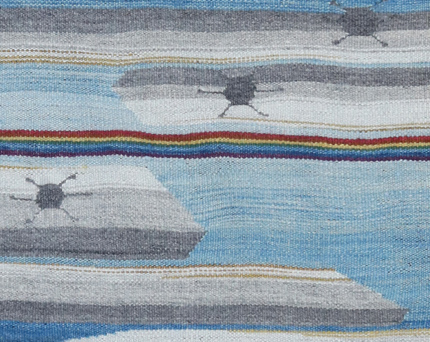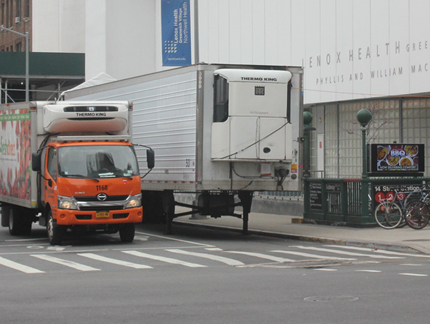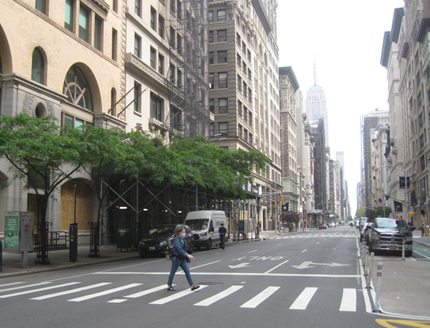
Covid-19 and the Field of Fiber Art |
Detail: Iris |
The flying carpet, Iris, started out as an exploration of the interaction of opposing natural forces, urban rural vistas, and ancient classical Greek mythology. When the designing was finished, the required yarns all prepared, and the loom warped, then the weaving finally commenced. After the bottom third was woven the unexpected arrived: the Global Pandemic commenced in early 2020.. Different localities have been impacted in greatly differing ways. In NYC Covid-19 quickly imposed complications upon reliably securing food and medication, particularly for susceptible seniors and people with common underlying medical conditions, such as hypertension and diabetes. As most food stores began closing down, that increased dependency in New York upon private trucking as illustrated below. The Fresh Direct refrigerated truck on the left is of course familiar to most. But how about the other refrigerated truck in the picture on the right? |
 |
That refrigerated truck on the right was the local neighborhood's portable morgue for the overflow of death in the community. This was similarly the case visible beyond the police barriers blocking off parts of Central Park. |
 |
The human morbidity and mortality of Covid-19 was multiplied by the near impossibility for New Yorkers to have been examined and treated in person for other serious medical problems. Unfortunately, the news prior to the Covid-19 outbreak did not widely report how many businesses in NYC were already shutting down in 2019 prior to any viral plague appearing on the distant horizon. Although the field of fiber art in the U.S. is on record not encouraging attention to business conditions that control so much in the arts, Covid has had a continuing long-term impact on the art, entertainment, and tourism industries in the U.S. now that all three have been made so economically dependent upon each other. But below are photos of what Covid-19 has done to this city's economic activity and the art world's market. |
 |
Above is a view of Fifth Avenue looking north from 16th Street just before noon on what used to be a heavily trafficked business day. Other major commercial arteries were similarly empty. |
 |
Here is a shot of Park Avenue South at East 14th Street facing north to the Pan Am Building in the distance, again just before noon on a business day. Since the advent of the Market Based Economy in the early 1980s, the arts in NYC have been increasingly dependent upon tourism. But tourism has been turned off. For NYC, a major concern has been how the arts can survive until that massive tourism can be revived. How will smaller and far less powerful art entities secure the funding to survive? In the fiber art community, the organizations are already competing energetically with each other for the same limited amount of donation money available. The field of contemporary fiber art permits very little advocacy to help confront the field's challenges. It certainly does not encourage rational problem solving discussions. Although the fiber arts are arguably the largest constituency of the craft media arts, it is the subject area characterized by the least transparent professional research practice. For decades, the field has been developed as a hobby for the enjoyment it provides its makers. As a result, it has the poorest economic and professional opportunity in the craft media based arts. The fiber arts have been been an art form for peoples and cultures throughout human history. Yet the contemporary fiber field suffers from multiple stunning deficiences of diversity regarding race, age, gender, and region. Individuals in the fiber arts are largely expected to be self-capitalized by savings, pensions, and/or support from spouses. Thus, over the past generation, the incredibly non-diverse field has suffered crucial losses. For example, the Handweavers Guild of America has lost about two thirds of its membership over the past three decades.1/ According to the last membership survey allowed by the board of The American Tapestry Alliance in 2015, there is serious reason to be alarmed about the greying of its membership without appropriate replenishment by younger generations.2/ |
When will fiber art's organizations begin to address openly what our field of fiber art has ignored in the past and what the future now imposes? We are told that economic and professional opportunity in the fibber field has improved to what it was prior to Covid. But the membership statistics and spiking dependency of art organizations upon contributions and fundraisers clearly testify to the contrary. So, perhaps we are awaiting a messenge from out of the Blue with far better news. |
Footnotes: 1/ Official membership in the Handweavers Guild of America has been based upon subscription to the guild's official publication, "Shuttle, Spindle & Dyepot." Federal regulations require magazine subscriptions via the U.S. Postal Service to be publicly declared annually in the publications themselves. In the winter issue of 1988-89 HGA declared that its subscribership/membership was 10,007. In the winter issue of 2019, HGA published that its official subscribership/membership statistics were 3,561. That is, as HGA approached the onset of Covid, HGA reported a loss of about 65% of its membership size over the past three decades. 2/ Back in 2015 was the last time the American Tapestry Alliance made age statistics available to the membership. Those statistics indicated that the average age of membership in ATA was approaching 70 years. Only 2% of the ATA membership was 39 years of age or younger, despite extensive efforts by ATA to attract younger generations.
|